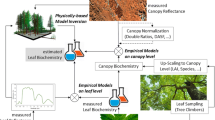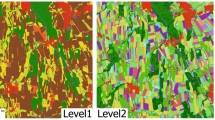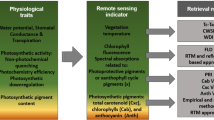Abstract
In numerous studies, spatial and spectral aggregations of pixel information using average values from imaging spectrometer data are suggested to derive spectral indices and the subsequent vegetation parameters that are derived from these. Currently, there are very few empirical studies that use hyperspectral data, to support the hypothesis for deriving land surface variables from different spectral and spatial scales. In the study at hand, for the first time ever, investigations were carried out on fundamental scaling issues using specific experimental test flights with a hyperspectral sensor to investigate how vegetation patterns change as an effect of (1) different spatial resolutions, (2) different spectral resolutions, (3) different spatial and spectral resolutions as well as (4) different spatial and spectral resolutions of originally recorded hyperspectral image data compared to spatial and spectral up- and downscaled image data. For these experiments, the hyperspectral sensor AISA-EAGLE/HAWK (DUAL) was mounted on an aircraft to collect spectral signatures over a very short time sequence of a particular day. In the first experiment, reflectance measurements were collected at three different spatial resolutions ranging from 1 to 3 m over a 2-h period in 1 day. In the second experiment, different spectral image data and different additional spatial data were collected over a 1-h period on a particular day from the same test area. The differently recorded hyperspectral data were then spatially and spectrally rescaled to synthesize different up- and down-rescaled images. The normalised difference vegetation index (NDVI) was determined from all image data. The NDVI heterogeneity of all images was compared based on methods of variography. The results showed that (a) the spatial NDVI patterns of up- and downscaled data do not correspond with the un-scaled image data, (b) only small differences were found between NDVI patterns determined from data recorded and resampled at different spectral resolutions and (c) the overall conclusion from the tests carried out is that the spatial resolution is more important in determining heterogeneity by means of NDVI than the depth of the spectral data. The implications behind these findings are that we need to exercise caution when interpreting and combining spatial structures and spectral indices derived from satellite images with differently recorded geometric resolutions.








Similar content being viewed by others
References
Atkinson, P. M. (1993). The effect of spatial resolution on the experimental variogram of airborne MSS imagery. International Journal of Remote Sensing, 14, 1005–1011.
Atkinson, P. M., & Tate, N. J. (2000). Spatial scale and geostatistical solutions: a review. The Professional Geographer, 52, 607–623.
Blöschl, G. (1999). Scaling issues in snow hydrology. Hydrological Processes, 13, 2149–2175.
Briggs, J. M., & Nellis, M. D. (1991). Seasonal variation of heterogeneity in the tallgrass prairie: a quantitative measure using remote sensing. Photogrammetric Engineering and Remote Sensing, 57, 407–411.
Chen, W., & Henebry, G. M. (2010). Spatio-spectral heterogeneity analysis using EO-1 Hyperion imagery. Computers & Geoscience, 36, 167–170.
De Cola, L. (1994). Simulating and mapping spatial complexity using multiscale techniques. International Journal of Geographic Information Systems 8(5), 411–421.
Ettema, C. H., & Wardle, D. A. (2002). Spatial soil ecology. Trends in Ecology & Evolution, 17, 177–183.
Garrigues, S., Allard, D., Baret, F., & Weiss, M. (2006). Quantifying spatial heterogeneity at the landscape scale using variogram models. Remote Sensing of Environment, 103, 81–96.
Garrigues, S., Allard, D., Baret, F., & Moisett, J. (2008). Multivariate quantification of landscape spatial heterogeneity using variogram models. Remote Sensing of Environment, 112, 216–230.
Goodin, D. G., & Henebry, G. M. (1998). Seasonality of finely-resolved spatial structure of NDVI and its component reflectances in tallgrass prairie. International Journal of Remote Sensing, 19, 3213–3220.
Goodin, D. G., & Henebry, G. M. (2002). The effect of rescaling on fine spatial resolution NDVI data: a test using multi-resolution aircraft sensor data. International Journal of Remote Sensing, 23, 3865–3871.
Goodin, D. G., Gao, J., & Henebry, G. M. (2004). The effect of solar zenith angle and sensor view angle on observed patterns of spatial structure in tallgrass prairie. IEEE Transactions on Geoscience and Remote Sensing, 41, 154–165.
Hall, M. R., Swanton, C. J., & Anderson, G. W. (1992). The critical period of weed control in grain corn (Zea mays). Weed Science, 40, 441–447.
Hornschuch, F., & Riek, W. (2009). Bodenheterogenität als Indikator von Naturnähe? 2. Biologische, strukturelle und bodenkundliche Diversität in Natur- und Wirtschafts- wäldern Brandenburgs und Nordwest-Polens. Waldökologie, Landschaftsforschung und Naturschutz, 7, 55–82.
Isaak, E. H., & Srivastava, R. M. (1989). An introduction to applied geostatistics. New York: Oxford University Press.
Lausch, A., Pause, M., Merbach, I., Gwillym-Margianto, S., Schulz, K., Zacharias, S., et al. (2012). Scale-specific hyperspectral remote sensing approach in environmental research. PFG, 5, 589–602.
Lausch, A., Pause, M., Merbach, I., Zacharias, S., Doktor, D., Volk, M., et al. (2013). A new multi-scale approach for monitoring vegetation using remote sensing-based indicators in laboratory, field and landscape. Environmental Monitoring and Assessment, 185, 1215–1235.
Levesque, J., & King, D. J. (1999). Airborne digital camera image semivariance for evaluation of forest structural damage at an acid mine site. Remote Sensing of Environment, 68, 112–124.
Mäkisara, K., Meinander, M., Rantasuo, M., Okkonen, J., Aikio, M., Sipola, K., Pylkkö, P. & Braam, B. (1993). Airborne Imaging Spectrometer for Applications (AISA), Digest of IGARSS’93, 2, 479–481 (Tokyo, Japan).
Malenovský, Z., Bartholomeus, H. M., Acerbi-Junior, F., Schopfer, J. T., Painter, T. H., Epema, G. F., et al. (2007). Scaling dimensions in spectroscopy of soil and vegetation. International Journal of Applied Earth Observation and Geoinformation, 9, 137–164.
Richter, R., & Schlapfer, D. (2002). Geo-atmospheric processing of airborne imaging spectrometry data. Part 2: atmospheric/topographic correction. International Journal of Remote Sensing, 23, 2631–2649.
Rogaß, C., Spengler, D., Bochow, M., Segl, K., Lausch, A., Doktor, D., et al. (2011). Reduction of radiometric miscalibration—applications to pushbroom sensors. Sensors, 11, 6370–6395. doi:10.3390/s110606370.
Rouse, J.W.J., Hass, R.H., Schell, J.A., Deering, D.W. (1974). Monitoring vegetation systems in the Great Plains with ERTS. In Proceedings Earth Resources Technology Satellite (ERTS) Symposium, 3rd., Greenbelt, MD, 10–14 Dec 1973, 309–317.
Sellers. (1985). Canopy reflectance, photosynthesis and transpiration. International Journal of Remote Sensing, 6, 1335–1372.
Siegmann, B. (2011). Klassifikation trockener Offenlandvegetation mit bildspektrometrischen Daten unterschiedlicher Auflösung im Naturschutzgebiet Döberitzer Heide - Ein Vergleich verschiedener Klassifikationsverfahren des maschinellen Lernens. Diplomarbeit, Martin Luther Universität Halle-Wittenberg, 114 pp.
Tarnavsky, E., Garrigues, S., & Brown, M. E. (2008). Multiscale geostatistical analysis of AVHRR, SPOT-VGT, and Modis global NDVI products. Remote Sensing of Environment, 112, 535–549.
Webster, R., & Oliver, M. A. (2001). Geostatistics for environmental scientists. Statistics in practice (p. 271). Chichester: Wiley.
Wu, J. (2009). Scale Issues in remote sensing: a review on analysis, processing and modeling. Sensors, 9, 1768–1793. doi:10.3390/s90301768.
Zacharias, S., Bogena, H., Samaniego, L., Mauder, M., Fuß, R., Pütz, T., et al. (2011). A network of terrestrial environmental observatories in Germany. Vadose Zone Journal, 10, 955–973.
Author information
Authors and Affiliations
Corresponding author
Rights and permissions
About this article
Cite this article
Lausch, A., Pause, M., Doktor, D. et al. Monitoring and assessing of landscape heterogeneity at different scales. Environ Monit Assess 185, 9419–9434 (2013). https://doi.org/10.1007/s10661-013-3262-8
Received:
Accepted:
Published:
Issue Date:
DOI: https://doi.org/10.1007/s10661-013-3262-8




